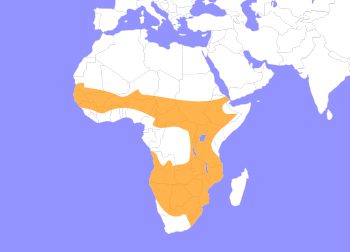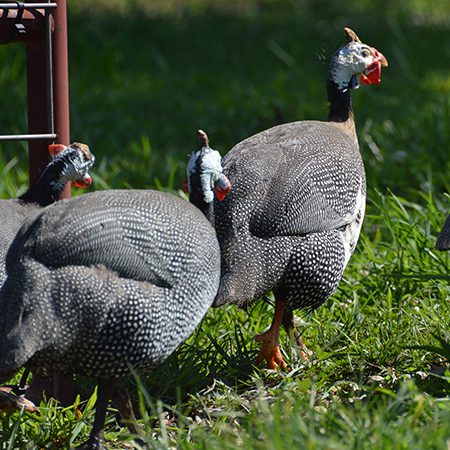Guinea Fowl (Helmeted)
Numida meleagris
The helmeted guinea fowl is the best known of the guinea fowl bird family, Numididae, and the only member of the genus Numida. It is native to Africa, mainly south of the Sahara, and has been widely introduced into the West Indies, Brazil, Australia and Europe. The helmeted guinea fowl is a large 21 to 23 inch bird with a round body and small head. They weigh about 2.9 lbs. The body plumage is gray-black spangled with white. Like other guinea fowl, this species has an unfeathered head. In this species it is decorated with a dull yellow or reddish bony knob, and bare skin with red, blue or black hues. The wings are short and rounded, as well they have a short tail. Various sub-species are proposed, differences in appearance being mostly a large variation in shape, size and color.
This species will typically form flocks outside the breeding season of about 25 birds that also roost communally. Guinea fowl are particularly well-suited to consuming massive quantities of ticks, which might otherwise spread lyme disease. These birds are terrestrial, and prone to run rather than fly when alarmed. Although they have the ability to have a short-lived explosive flight and rely on gliding to cover extended distances. Helmeted guinea fowl can walk 10 km and more in a day, and are great runners. They make loud harsh calls when disturbed. Their diet consists of a variety of animal and plant food; seeds, fruits, greens, snails, spiders, worms and insects, frogs, lizards, small snakes and small mammals. guinea fowl are equipped with strong claws and scratch in loose soil for food much like domestic chickens, although they seldom uproot growing plants in so doing. They may live for up to 12 years in the wild.

This species of Guinea Fowl is native to parts of central and southern Africa, and have since been introduced to Madagascar.
HABITAT -They live in semi open habitats such as savannas and semi deserts, some species inhabit forests.
DIET -They are omnivorous, eating seeds, fruits, greens, snails, spiders, worms, insects, frogs, lizards, and small snakes.
FUN FACT -While capable of flight, they are mainly terrestrial choosing to run rather than fly.
SOCIAL BEHAVIOR -They will form monogamous mating pairs. Sometimes males show aggression during breeding season.
ACTIVITY -They are diurnal being most active during the day and resting during the evening.
PREDATORS -Predators include wildcats, dogs, wolves, humans, snakes, and crocodiles.
SIZE -They are typically 21 to 23 in weighing about 2.9 lb.
RELATIVES -There are various species of guinea fowl including the crested guinea fowl.
CONSERVATION -Guinea Fowl are categorized as LC (Least Concern) by the IUCN.
Cub Creek Animal Care Information
Housing - Our Guinea Fowl flock roams freely across the ranch! You can regularly find them exploring around camps fields, or usually down in the animal area by llama pond! You’ll never know when you need to make guinea fowl xing stop when walking on a trail. They can usually be found roosting in trees around camp when they sleep. Some of our more unique Guineas live in our Aviary because we want them to be seen all the time.
Diet - Primarily our Guinea Fowl will forage around camp and eat wild vegetation to stay healthy! They will regularly eat plant material, seeds, insects, and small invertebrates. In addition, their diet is supplemented with high quality game bird food, or bird seed. These can be found distributed all throughout camp for our free roaming avian friends and in bowls in the Aviary. In the Aviary, they have access to fresh water daily while the rest have many different water sources around camp to choose from.
Enrichment - Being able to roam around camp gives the peafowl plenty to do as they can explore and entertain themselves. In the Aviary, our peafowl live with other species of birds, including pigeons, farm chickens, and silkie chickens. This multi-species environment gives the birds plenty of interaction to enrich them every day.

